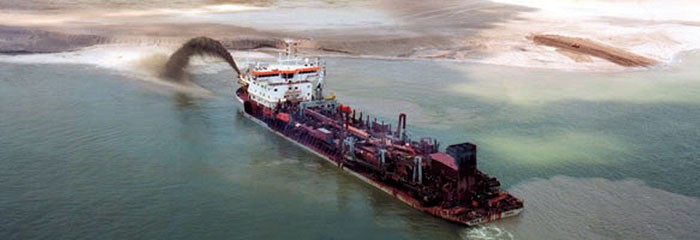Dredging & Reclamation

Dredging of material can be done either hydraulically or mechanically. Hydraulic dredges use hydraulic pumps to produce a slurry of the dredged material, are typically used when there is much material to remove and it can be easily transported long distances via a pipeline attached to the dredge. Sometimes a cutterhead is attached to the dredge intake to loosen hardened material. Mechanical dredges remove the sediments via mechanical methods which can include grab dredges (clamshells & buckets), backhoes or bucket ladder dredges. Most common mechanical dredges used on Great Lakes projects are the grab or bucket type dredge.
In summary the definition of dredging is the subaqueous or underwater excavation of soils and rock. The process consists of four phases:
In summary the definition of dredging is the subaqueous or underwater excavation of soils and rock. The process consists of four phases:
- Excavation
- Vertical transport
- Horizontal transport
- Placement or use of the material dredged.
From the beginning of civilization, people, equipment, materials, and commodities have been transported by water. To do this, the channel depths of many waterways needed to be increased to provide access to ports and harbours. Most major ports in the world require dredging at some time to enlarge and deepen access channels, waterways, and turning basins, and to provide appropriate water depths along waterside facilities. These channels often require frequent and regular maintenance dredging. In the case of fluvial navigation, dredging is also required to construct and maintain vital links to inland ports and facilities.
As population density along the coastlines and riverbanks increases, dredging is also used for to protect against flooding and erosion, as well as to create recreational facilities like beaches through sand nourishment.
Dredging is also used for the installation of energy facilities such as offshore drilling platforms and oil and gas pipelines and the construction of wind farms in the water. Dredging can also be used to recover minerals, gems, precious metals, and fertilizers, or the removal of overlying material to reach such deposits.
Dredging can also provide construction materials such as sand, gravel, shell and clay, or provide landfills, including the construction of industrial and residential areas, highways, dams, airports, causeways and habitats for birds and other forms of wildlife.
Another more recent use of dredging is to remove or remediate subaqueous pollutants and improve water quality and sediment habitats. This type of dredging operation is used as a means to clean-up contaminated waterways. Environmental dredging is the removal of contaminated sediments from a water body for purposes of sediment remediation.
As population density along the coastlines and riverbanks increases, dredging is also used for to protect against flooding and erosion, as well as to create recreational facilities like beaches through sand nourishment.
Dredging is also used for the installation of energy facilities such as offshore drilling platforms and oil and gas pipelines and the construction of wind farms in the water. Dredging can also be used to recover minerals, gems, precious metals, and fertilizers, or the removal of overlying material to reach such deposits.
Dredging can also provide construction materials such as sand, gravel, shell and clay, or provide landfills, including the construction of industrial and residential areas, highways, dams, airports, causeways and habitats for birds and other forms of wildlife.
Another more recent use of dredging is to remove or remediate subaqueous pollutants and improve water quality and sediment habitats. This type of dredging operation is used as a means to clean-up contaminated waterways. Environmental dredging is the removal of contaminated sediments from a water body for purposes of sediment remediation.


